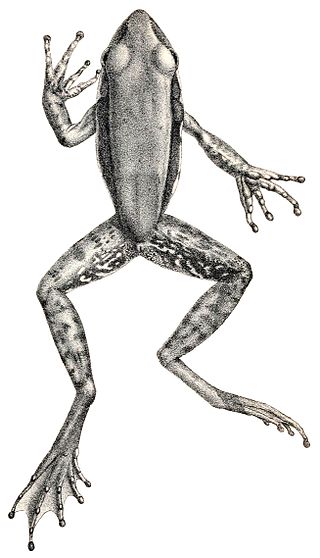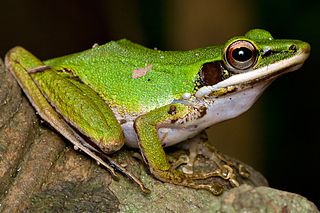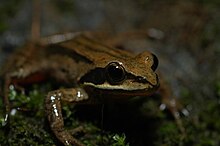
Rana is a genus of frogs commonly known as the Holarctic true frogs, pond frogs or brown frogs. Members of this genus are found through much of Eurasia and western North America. Many other genera were formerly included here. These true frogs are usually largish species characterized by their slim waists and wrinkled skin; many have thin ridges running along their backs, but they generally lack "warts" as in typical toads. They are excellent jumpers due to their long, slender legs. The typical webbing found on their hind feet allows for easy movement through water. Coloration is mostly greens and browns above, with darker and yellowish spots.

Rana amurensis is a species of true frog found in northern Asia. Rana coreana was previously included in this species as a subspecies.
The Huanren frog is a species of true frog found in East Asia. It was originally believed to be endemic to Huanren County, Liaoning, China, but was later also found in South Korea; it is presumed to be present in North Korea, as well. It is closely related to the Dybowski's frog, Rana dybowskii, and specimens collected before 1991 were incorrectly identified as that species. Distinguishing factors include the absence of a vocal sac.
Amolops tuberodepressus is a species of frog in the family Ranidae. It is endemic to Yunnan, China and known from Wuliang and Ailao Mountains in Jingdong County. Once suspected to be synonym of Amolops mantzorum, its validity was confirmed with molecular methods in 2014.

The common green frog is a frog species of in the true frog family Ranidae; some sources still use the old name Rana erythraea. It lives in Southeast Asia and is also known as green paddy frog, red-eared frog or leaf frog. The last name, however, commonly refers to the Neotropical tree frogs which make up the subfamily Phyllomedusinae. These are not closely related to H. erythraea, belonging to family Hylidae instead.
Odorrana exiliversabilis is a species of frogs in the family Ranidae that is endemic to southeastern China where it is found in Fujian, western Zhejiang, and southern Anhui provinces. These frogs can be found in mountain forest streams and are common in suitable habitat. The species is not considered threatened by the IUCN.
Papurana garritor is a species of frog in the family Ranidae. It is endemic to New Guinea and widely distributed, found in both Indonesian and Papua New Guinean parts of the island. Common name Eilogo Estate frog has been coined for it.
The Guatemala plateau frog is a species of frog in the family Ranidae. It occurs in Guatemala and southern Mexico. It is impossible to morphologically distinguish this species from Lithobates forreri and Lithobates brownorum, and the validity of it has been questioned. It is an uncommon frog that inhabits cloud forests, including degraded forest, and grassland. Breeding takes place in streams and small temporary ponds. It is threatened by habitat degradation caused by agricultural encroachment, wood extraction, human settlement, and water pollution.

The highland frog, also known as the masked mountain frog, is a species of frog in the family Ranidae, known from El Salvador, Guatemala, Honduras, Mexico, and Nicaragua. Its natural habitats are subtropical or tropical moist lowland forests, subtropical or tropical moist montane forests, rivers, and freshwater marshes. It is threatened by habitat loss.

The Kampira Falls frog, also known as the Yaeyama harpist frog or harpist brown frog, is a species in the true frog family (Ranidae). Until recently known as Rana psaltes, it is found on Ishigaki and Iriomote in the Yaeyama Islands of Japan, as well as on Taiwan.
Rana sangzhiensis is a species of frog in the family Ranidae, the "true frogs". It is endemic to China. It is known only from Mount Tianping, in Sangzhi County, Hunan, and depending on the source, from Mount Dadong in Lianxian County, Guangdong, or from Mount Emei in Sichuan. Common names Sangzhi frog and Sangzhi groove-toed frog has been proposed for it. It was formerly classified in the genus Pseudorana.
Chalcorana chalconota is a species of "true frog", family Ranidae. It is endemic to Indonesia and occurs in southern Sumatra, Java, Bali, and a few smaller islands. Populations previously assigned to this species now belong to a number of other Chalcorana species, leading to the current delineation of Chalcorana chalconota with a much narrower range. This species is also known as the Schlegel's frog, brown stream frog, copper-cheeked frog, or, among with many other species, white-lipped frog.

Hylarana taipehensis is a species of "true frog", family Ranidae. It has several common names, including Taipei frog, Taipei grass frog, two-striped grass frog, or striped slender frog. Following its redelimitation in 2019, its range is now believed to extend from Taiwan and southern China to Vietnam, Laos, Cambodia, and eastern Thailand.

Papurana kreffti is a species of true frog, family Ranidae. It is native to New Ireland and Buka Island and the Solomon Islands. The specific name kreffti honours Gerard Krefft, a German adventurer who settled in Australia and became there to be regarded as the father of Australian herpetology. Common names San Cristoval frog and San Cristobal treefrog have been coined for it.
Papurana milleti is a species of true frog. Originally described in the genus Rana, then Hylarana and Indosylvirana, it is now placed in Papurana. It is native to Cambodia, China (Yunnan), Thailand, Vietnam, and quite possibly Laos. It is a locally common frog found by ponds and streams in seasonal tropical forests.
Chalcorana parvaccola is a species of "true frog" in the family Ranidae. It is endemic to Sumatra, Indonesia. It was split off from Chalcorana chalconota by Robert Inger and colleagues in 2009, along with a number of other species. The specific name parvaccola is derived from Latin parvus meaning small and accola meaning neighbor, and refers to this species being smaller than its "neighbor", the related Sumatran species Chalcorana rufipes.

Chalcorana raniceps, also known as the copper-cheeked frog, white-lipped frog, or Peters' Malaysian frog, is a species of "true frog" in the family Ranidae. It is endemic to Borneo, including Brunei Darussalam, Kalimantan (Indonesia), and Sarawak (Malaysia), although it is likely to occur more widely. Previously mixed with Chalcorana chalconota and believed to have much wider distribution, its range was delimited to Borneo in the revision of "Rana chalconota" complex by Robert Inger and colleagues in 2009.









